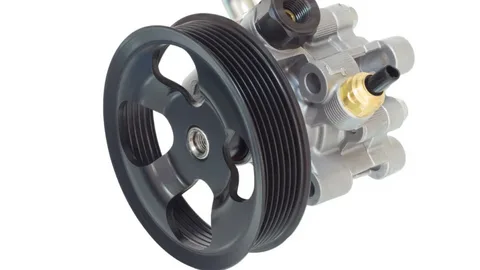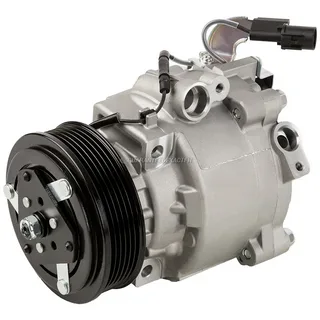Your Subaru Forester is more than just a vehicle; it’s your trusted companion on countless adventures. While you may focus on oil changes and tyre rotations, the power steering pump is often overlooked. This small yet mighty part is vital in ensuring smooth handling and maneuverability. Neglecting its maintenance can lead to costly repairs or even compromise your driving experience. Let’s dive into why keeping an eye on your Forester Power Steering Pump is essential for performance and safety so you can enjoy every mile confidently.
Understanding The Power Steering Pump
The power steering pump is crucial to your Subaru Forester’s steering system. It helps to make turning the wheel smoother and easier, especially at low speeds or when parking. Providing hydraulic pressure assists you in navigating tight turns with minimal effort.
This pump operates by pushing fluid from the reservoir into the steering gear. This pressurized fluid creates a force that aids in maneuvering the vehicle effortlessly. With this assistance, drivers could turn their wheels, making driving less enjoyable and more physically demanding.
In most vehicles like the Forester, there are two main types of power steering pumps: hydraulic and electric. Hydraulic systems rely on belt-driven pumps powered by your engine, while electric systems use an electric motor for operation. Both serve similar purposes but have different mechanisms.
Regular maintenance of your power steering pump can prevent wear and tear over time. Neglecting this component can lead to decreased performance and potential failure. Understanding its function lets you appreciate why keeping it in good shape is essential for overall driving comfort.
A well-functioning power steering pump enhances handling and safety on the road. When everything works as intended, you’ll find every drive through winding roads or city streets much more enjoyable.
Role Of the Power Steering Pump In Vehicle Performance
The Crucial Role of the Power Steering Pump
The power steering pump is essential for enhancing your driving experience by providing hydraulic pressure for smooth and effortless steering. This is particularly important for navigating tight corners or parking maneuvers, where steering could otherwise become strenuous.
Continuous Fluid Delivery for Optimal Performance
As you drive your Subaru Forester, the power steering pump continuously delivers fluid to the steering gear, facilitating easier wheel turns. This ensures optimal vehicle performance and responsiveness, crucial for maintaining control at high speeds or on uneven terrain.
Contribution to Overall Safety
A properly functioning power steering pump significantly contributes to overall safety. The ease of maneuverability provided by the pump can be crucial in emergency situations that require quick directional changes. Issues with the pump can hinder effective steering.
Impact on Vehicle Component Communication
Reliable power assistance from the steering pump is vital for effective communication between various vehicle components. A malfunctioning pump can lead to difficulty handling and create additional strain on other mechanical systems in the car.
Importance of Maintenance for Longevity
Investing time in understanding and maintaining your Forester’s power steering pump leads to better performance and longevity of your vehicle. Proper care ensures that the pump functions effectively, contributing to the overall reliability of your car.
Benefits Of Regular Maintenance
Maintaining your Subaru Forester’s power steering pump is crucial for optimal performance. One key benefit is enhanced vehicle safety. A well-functioning power steering system ensures you can maneuver your car effortlessly, especially in tight spots or during sudden stops.
Another advantage is improved fuel efficiency. When the power steering pump operates smoothly, it reduces strain on the engine, allowing it to work more efficiently. This means fewer trips to the gas station and more money saved over time.
Additionally, routine checks help extend the lifespan of your vehicle’s components. By addressing minor issues early on, you can prevent them from escalating into costly repairs. It’s a smart investment that pays off in longevity and reliability.
Regular maintenance also contributes to maintaining resale value. A history of consistent care shows potential buyers that you’ve taken good care of your Forester, making it easier to sell when the time comes.
Staying proactive with maintenance can enhance overall driving comfort. A properly functioning power steering system provides smooth handling and responsive control—key ingredients for an enjoyable driving experience.
Common Issues with The Mazda Power Steering Pumps
The Mazda Power Steering Pumps can experience several common issues that may affect performance. One prevalent problem is fluid leaks, which can occur due to worn seals or damaged hoses. If you notice spots of fluid under your vehicle, it’s time to inspect the system.
Another issue that often arises is a whining noise when turning the wheel. This sound usually indicates low fluid levels or air bubbles trapped in the system. Ignoring this could lead to more significant problems down the road.
Overheating is also a concern for power steering pumps. Excessive heat can cause components to wear out faster than usual, leading to premature failure. Regular fluid and pump temperature checks will help prevent this situation.
In some cases, drivers also report stiff steering responses. This condition might stem from a failing pump that cannot provide adequate pressure or flow throughout the system.
Erratic behaviour while steering can signal issues with your power steering pump as well. If you feel sudden changes in resistance when turning, it’s crucial to address these symptoms promptly before they escalate into severe damage.
Signs That Your Power Steering Pump Needs Attention
A well-functioning power steering pump is crucial for smooth driving, especially in your Subaru Forester. If you notice changes in how your vehicle handles, it may be time to investigate further.
One of the first signs that something’s amiss is an unusual noise. If you hear whining or grinding sounds when turning the wheel, this could indicate low fluid levels or a failing pump.
Another red flag is stiff steering. If you find it increasingly difficult to turn the steering wheel, do not ignore it. This can lead to more significant issues down the road if left unchecked.
Leaking fluid around the pump area also warrants immediate attention. Power steering fluid should remain contained; leaks can affect performance and cause damage over time.
Check for warning lights on your dashboard. An illuminated power steering light signals a problem that needs prompt investigation before it escalates into more costly repairs. Awareness of these signs ensures better care for your Forester’s power steering system.
Maintenance Tips For The Power Steering Pump
Regular inspections are essential to keeping your Subaru Forester’s power steering pump in top shape. Start by checking the fluid level frequently. Low fluid can lead to increased wear and tear on the pump. Make it a habit to inspect the reservoir at least once a month.
Next, always use the recommended power steering fluid for your vehicle. An incorrect type can damage seals and internal components, leading to costly repairs. Stick with what’s suggested in your owner’s manual for optimal performance.
Pay attention to any unusual noises while turning the wheel. A whining or grinding sound may indicate low fluid or potential issues within the pump. If you notice these sounds, investigate promptly before problems escalate.
Also, avoid sudden maneuvers when driving; gentle turns reduce stress on all steering components, including your power steering pump. This simple practice will extend its life significantly.
Consider scheduling professional maintenance during routine service intervals. A technician can check for leaks or issues needing clarification during casual inspections and ensure everything runs smoothly.
How To Inspect And Test The Power Steering Pump
Inspecting your Forester power steering pump is essential for ensuring optimal performance. Start by checking the fluid level in the reservoir. Low fluid levels can indicate a leak or contamination, which may affect the pump’s function.
Next, look for any signs of leaks around the pump and connected hoses and connected hoses. A wet spot or puddle under your vehicle can signal something isn’t right. If you notice any dampness, it’s time to investigate further.
Listen closely while driving; unusual noises like whining or grinding might suggest an issue with the power steering pump. These sounds often indicate that air has entered the system or components are worn down.
Another method to test functionality is to slowly turn the steering wheel from side to side at a standstill. If there’s significant resistance, this could mean a problem with the power steering pump or its related parts.
Consider using a pressure gauge during testing if you’re comfortable with more advanced diagnostics. This tool helps determine whether your Forester’s power steering system operates within recommended specifications, pinpointing issues before they escalate.
When To Replace The Power Steering Pump
Recognizing when to replace your Forester power steering pump is crucial for maintaining optimal vehicle performance. A well-functioning pump ensures smooth steering and overall driving comfort. However, specific signs indicate it might be time for a replacement.
If you notice any whining or groaning noises while turning the wheel, it’s often a red flag. These sounds can suggest internal wear or insufficient fluid levels. Another common symptom is difficulty in steering, which may feel heavy or unresponsive compared to usual handling.
Leaks around the power steering pump also signify trouble. Fluid leaks impact performance and can lead to further damage if left unchecked. Please pay attention to puddles beneath your car; they could indicate failing seals or hoses.
Vibration in the steering wheel during turns can also hint at pump issues. This sensation suggests that air may be trapped within the system, impairing its efficiency and safety on the road.
Check your dashboard warning lights regularly. If you see alerts about the power steering system, consult a professional immediately—delaying action could worsen problems.
Conclusion
Maintaining your Subaru Forester’s power steering pump is essential for optimal vehicle performance. This component ensures smooth and precise steering, improving driving safety and comfort.
Regular maintenance can help prevent costly repairs down the line. By paying attention to this important system, you can avoid unexpected breakdowns that disrupt your travels or daily routines.
Awareness of common issues associated with the power steering pump allows you to tackle problems early on. Recognizing signs like unusual noises or difficulty steering keeps your Forester running smoothly.
Implementing simple inspection tips can make a significant difference, too. Checking fluid levels and listening for odd sounds during drives creates an opportunity to address potential concerns proactively.
Investing time in understanding and caring for your power steering pump pays off immensely. A well-maintained vehicle enhances performance and longevity while ensuring every drive remains enjoyable and safe.
FAQs
One common question is: How often should I check my Forester’s power steering fluid?
The best answer is to inspect it every 3,000 miles or during regular service intervals. Regular checks help catch any leaks early.
What’s the average lifespan of a power steering pump?
With proper care and timely maintenance, many pumps last between 100,000 to 150,000 miles before needing replacement.
Remember that being proactive can save time and money in the long run by ensuring your Subaru performs smoothly. Your vehicle deserves attention just as much as any other investment!




